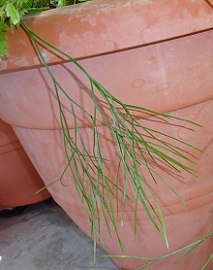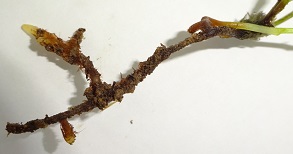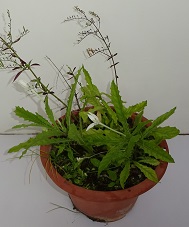| Home | Nature Weekly Index |
25 January 2015 | Whisk Fern (Psilotum nudum) |

 There was a time that I was looking high and low for this fork-like fern
(Psilotum nudum) to take some pictures. Strictly speaking, the Whisk Fern is not
a fern but a fern-like plant. It is considered to be a primitive plant that lacks roots and leaves. Instead, it has tiny outgrowths
on the stem known as enations. As the stem is weak, larger plant tends to be drooping in appearance instead of erected.
There was a time that I was looking high and low for this fork-like fern
(Psilotum nudum) to take some pictures. Strictly speaking, the Whisk Fern is not
a fern but a fern-like plant. It is considered to be a primitive plant that lacks roots and leaves. Instead, it has tiny outgrowths
on the stem known as enations. As the stem is weak, larger plant tends to be drooping in appearance instead of erected.
 Whisk Fern is a small plant with the rhizome (modified stem) buried underground. In order to have a closer look at its rhizomes,
I decided to dig them up from one of my pots that had several of the plants growing in it. This plant started to appear in my pots
spontaneously in 2011. It had been proliferating very well in a large pot where the
Oak-leaf Fern (Drynaria quercifolia) reside, which I had shared in
a note in November 2014.
Whisk Fern is a small plant with the rhizome (modified stem) buried underground. In order to have a closer look at its rhizomes,
I decided to dig them up from one of my pots that had several of the plants growing in it. This plant started to appear in my pots
spontaneously in 2011. It had been proliferating very well in a large pot where the
Oak-leaf Fern (Drynaria quercifolia) reside, which I had shared in
a note in November 2014.
After slowly dissecting the whole pot that contained other small plants, I gathered a total of 9 Whisk Fern. All of them were relatively young compared to the ones found in the larger pot that housed the Calabur Tree (Muntingia calabura). The rhizomes were not too deep, probably at a depth of about 1-2 cm beneath the soil. However, they tend to be quite fragile. Even with utmost care on my part during the retrieval, I still broke one of them. I might have broken more since it was hard to differentiate the small rhizomes from the surrounding soil materials.
The pictures below showed the pot that was sacrificed and the Whisk Fern harvested. The plant with white flower in the pot was Hippobroma longiflora while the one standing tall was Andrographis paniculata.




The plant is expected to bear sporangia (spore-containing bodies) along its stem. This had yet to take place in the plants available in my pots.